Makers Of Siberia talk with art critic Oksana Budulak at the critically acclaimed Dark Vat artist residency
Author: Distil Ennui | Post Date: 28-05-2019.... The uniqueness of this project is that the initiative came purely from the artist himself, this is very rare,' explains Oksana. - 'It seems to me that he is a mason who has a mission before humanity - to help everyone; and yet this is clearly the most difficult art residency in the career of Alexander. This is how artists can learn not to fear their ambitions '
Find the original article in Russian here.. makersofsiberia.com/zhurnal/dark-vat-2019.html
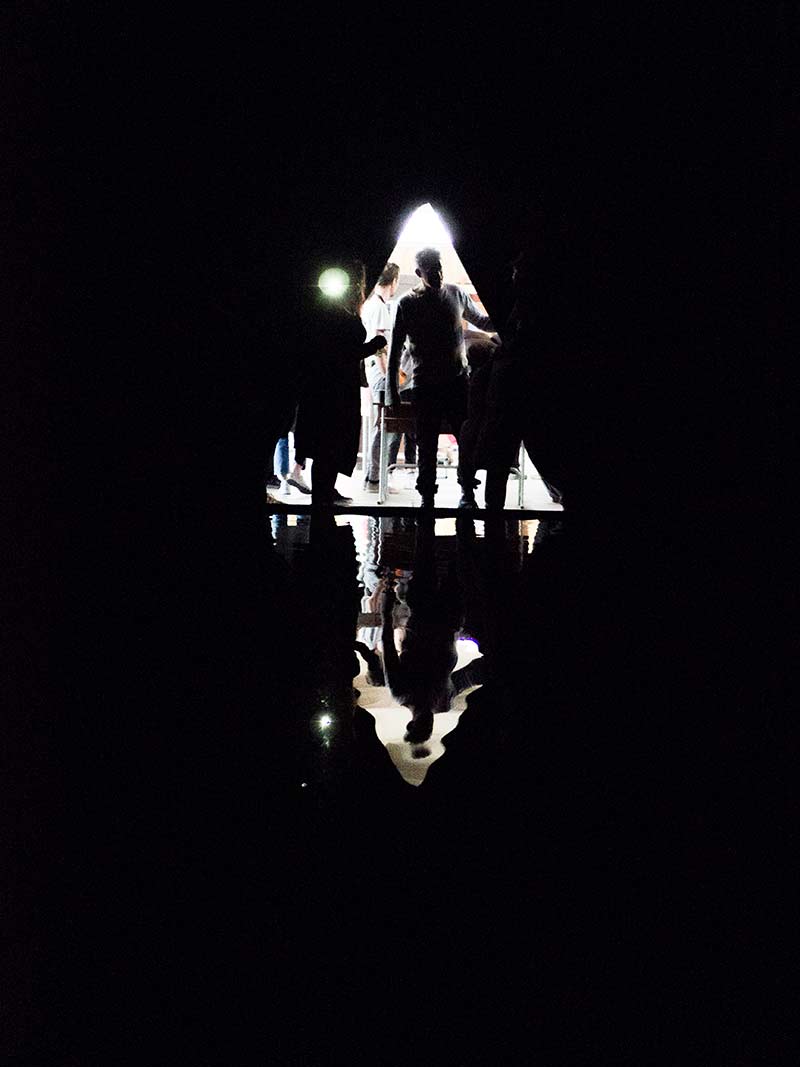
Alexander James Hamilton & exhibition visitors enter the installation titled 'Dark Vat'.
ENGLISH TRANSLATION
It's time to blink: Results of the Krasnoyarsk art residence 'Dark Vat' come to light.
In Krasnoyarsk, the art residence of Dark Vat hosted by British artist Alexander James Hamilton was complete. For eight weeks, 12 young artists, mostly from Krasnoyarsk, were engaged in creative interventions in the workshop of the former Kvant factory. We visited the exhibition finisage and became a little bit “addicted”.
Dark Vat - an anagram from the word kvadrat; in translation it means “black vat”, and also successfully refers to the name of the loft project “Kvadrat”, in whose premises the residence took place. In the original factory photographic paper was produced for decades during Soviet era that has been dissused for many decades, Alexander James Hamilton created a black water reflection pool measuring 96 square meters. Inside - 12 tons of water, which is more like crude oil in color. This dark matter was given as impetus seed material to the artists selected personally by Hamilton.
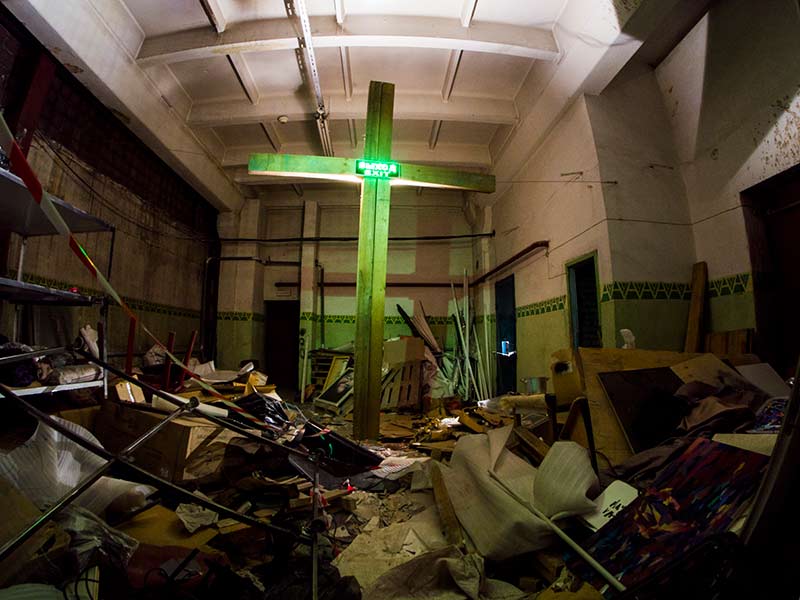
'Exit'. Installation at Dark Vat . Dedication to Nancy Fouts, British American artist & friend who passed away in April 2019
On the opening day, visitors found themselves in an industrial loft in the style of Petersburg's “Floors”: dilapidated walls, muddy glass, blocks, pipes, and a concrete floor. One of the participants said that all these weeks in the morning it was hard for him to wake up - perhaps, as they say, because the walls are saturated with chemical fumes. The first nine days of the residence went on to remove layers of dust and remove mountains of garbage from the room.
One of the main promises of Hamilton is ecological. The artists worked only with what they found in the factory: from doors, iron shelves, laminate flooring, clothes, boxes, metal structures and even medallions under the horns of a skull. Creating a tragic baroque mess, the vast space was decorated with fading bouquets and empty wine bottles with candles burning in them - all this remained from the wedding that the creator of Dark Vat played on the third day after opening.
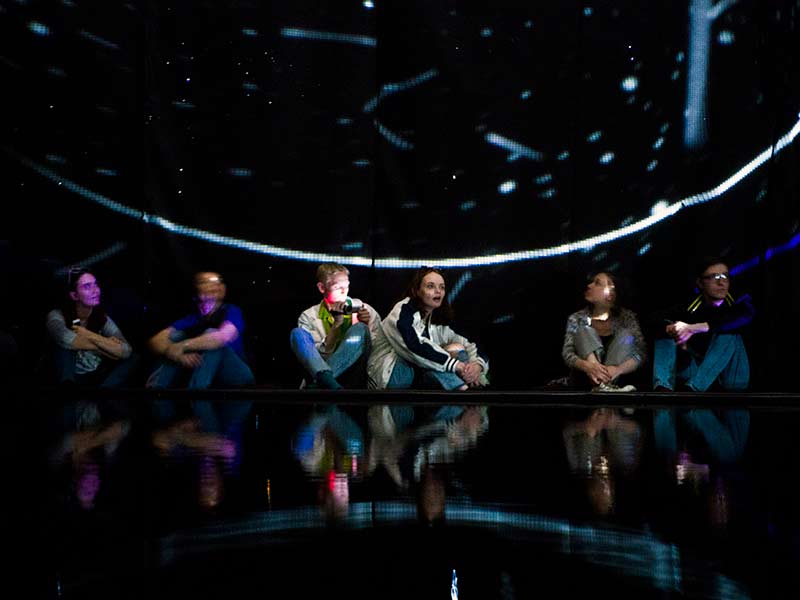
installation view of visitors inside the 'Dark Vat'
Collaboration with video artist Inna Shestakova, Alexey Shidlovsky and Alexander James Hamilton.
A month ago, the studio was presented to journalists & the media world. Then the black vat was not surrounded by a huge black curtain. In the evening, the spotlight fell on the trembling water, and the shadows of the waves walked along the walls. It felt like you were at the bottom of the pool. On the opening day to the vat, visitors were allowing in groups to view the installation. When you find yourself in a dark room, you can only see that water is splashing at your feet. Then, above it, under electronic minimalist music, figures, DNA molecules, a deer antler butterfly, planets begin to emerge in the projector's beam — it all spins, disappears, as if drowning in water and playing with reflection. This is a video art “Loop” of Inna Shestakova and Alexey Shydlovsky. They met thanks to Alexander. Inna shows sketches: “This is calcium, which served as one of the causes of the death of dinosaurs, and other various substances — nettle under a microscope, gold, chemical compounds.
Cooperation, cross-pollination - this was exactly what Alexander wanted. As a result, as art critic Oksana Budulak put it: “At the exhibition, there were many micro histories, to the extent that one artists process took root in the style of another.” We see large mirrors, painted in the style of Jackson Pollock, with dollar signs. The works have the names of Dollores and Dollarina - the graphic concept belongs to Andrei Shmaly, the incarnation is to Alexander Hamilton. In another picture, the sun is reflected in black water, but there is no object in the sky - this is the tandem of Andrey and Yegor Pasta and Alexander.
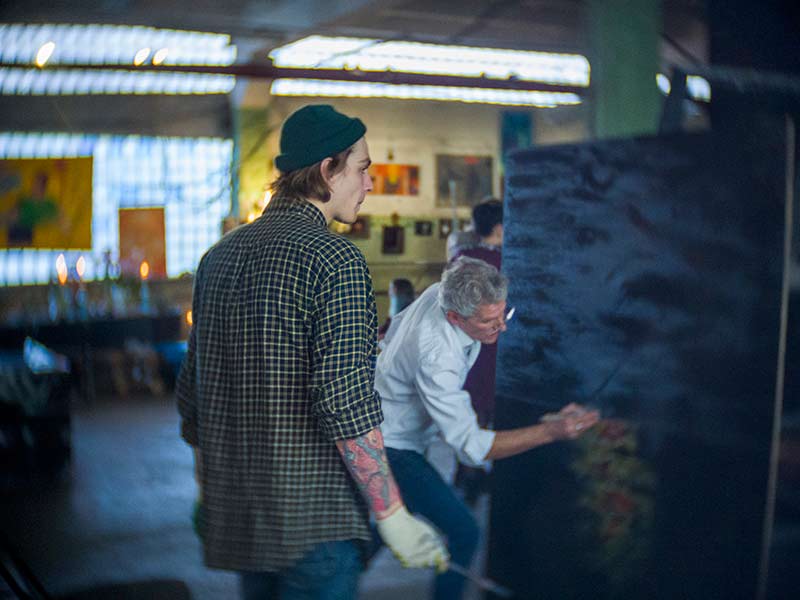
Another double work belongs to the brush of Mikhail Ptitsyn and Ksenia Galkina - a married couple who came from Moscow. We see the family at the table, but instead of food there is emptiness; in the center of the table is a black saucepan, and a two-headed eagle roars overhead. Visitors who do not know how to interpret what they see are impressed by the scale and cartoon-crazy faces of the people, the authors themselves pointed out the acute social character of the picture and the roll with the black vat.
The studio space for creating great art is what the participants of the residence lacked in everyday life. They agree - there is no such place in Krasnoyarsk. Hence, probably, the general portrait of the Krasnoyarsk independent artist, who paints in the apartment on his knee, and happily uses the opportunity to kill the city wall at some graffiti contest.
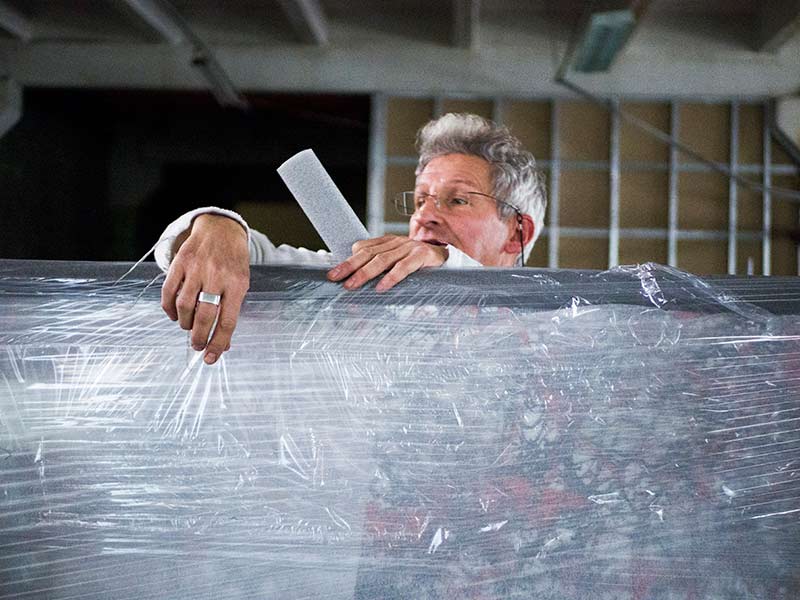
Dark Vat's 600 square meters gave the photographer Egor Paste the opportunity to do abstract painting for the first time. And Vadim Luke, in general, made a similarity of a home studio in the far corner: favorite books stand on the shelves, several tables are covered with paintings, and a number of a pillowhouse on which he rested, creating his greatest creations. Almost all the time while the opening was going on, Vadim sat, drawing at the table. In this, it seems, both the lifestyle and the artistic language are intertwined: he infinitely draws with a felt-tip pen in the style of doodling, either the signs of an alien language, or the words of actually existing Indian mantras. Here he depicted Akash - the Indian embodiment of the ether, and here - a semblance of the Chinese round calendar. Together with the artist Andrei Shmaly they created a picture in which a man and a full woman ride a silver dog on a skateboard. In front of the canvas there are two candles in memory of Vadim's grandparents. The work is located inside a cave-like room.
I asked the artists about the main lesson that the residence gave. “Alexander teaches that it is necessary to create through hard work and dedication, taking into account the fact that the works should be sold,” said Alexey Akimov, who photographs using the freezelight effect. - Art should be fun - this is the first, to be sold - the second: then you are doing what you love, you are a sought-after artist and you don’t have to think where to make money on the side. When you make art, you need to understand how to promote it in order to sell it to fund the next. First, you do something, and then you think about how it can be expanded, and not initially create a product for sale. Wooden painted spoon will go to tourists, but this is not what we are interested in. When you have a name, it's easier for you to do what you want. ” Hamilton adds: “It’s foolish to be an artist and not realize that sometimes you have to sell a painting or two. Unless you are a philanthropist.
The experience of communicating with artists has shown that these are modest, talented, full of outstanding ideas and thoughts of people who lack a little ambition. On this score, Hamilton explains: “I am interested in only one type of artist - the one that will go down in history, those that did something. Otherwise, you're just a bloody decorator. ” And this is an important pilisophical core meaning of the residency.
“To be an artist in the European sense is to work,” notes Oksana Budulak. In this sense, "Alexander Hamilton is a sort of Stolz in comparison with the Krasnoyarsk Oblomov: his eyes are burning, activity is boiling like thunder; sociable, good sense of humor and world wise."
“The uniqueness of this project is that the initiative went from the artist, this is very rare,” explains Oksana. - It seems to me that he is a mason who has a mission before humanity - to help everyone. Yet clearly this is the most difficult art residency in the career of Alexander so far. This is how artists can learn not to fear their ambitions. ' Krasnoyarsk citizens are lazy, just like Russians in principle. Pedagogical work is carried out in this residence, although usually artists are simply given space, and they create by themselves. Alexander set the conditions: he selected participants himself, became involved in collaborations, and worked dilligently alongside them. ”
It seems that artists are close to the idea of creating a community. “It is important for them for socialization,” continues Oksana. - In Soviet times there was a tradition of summer cottages - members of the union went to a pleasant area in the open air. When you are young, the feeling of the shoulder is important. It is like a family. When you have one idea at all, the results improve exponentially. This is a group psychological therapy. ” Photographer Oleg Deetz confirms that it would be nice if such an experience led to the creation of an urban community, but for this you need someone who gathers everyone. "People baton in terms of organization," - he argues.
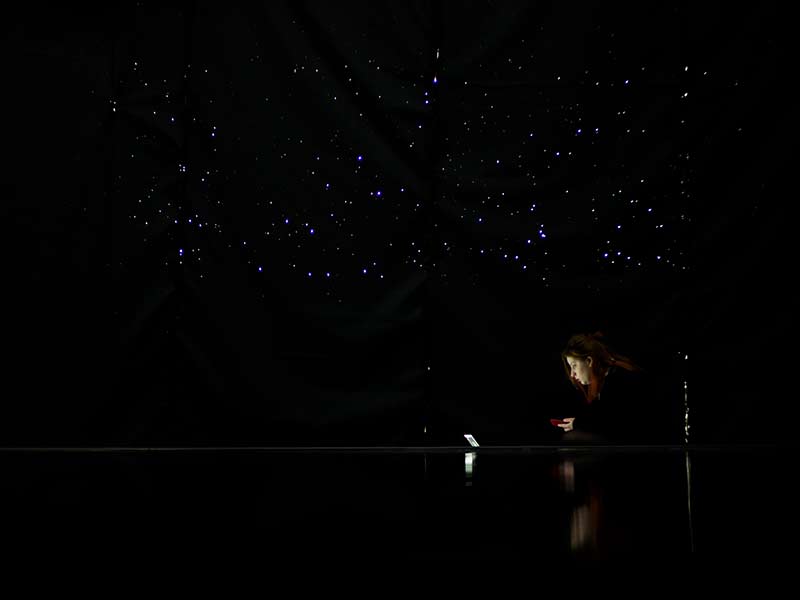
Video artist Inna Shestakova working inside 'Dark Vat'.
On the day of the first opening of the exhibition, Alexander gave seven interviews to the local media, but his main task was to substitute himself and divert all the cameras onto the young artists', to engage them directly with the cameras lenses, to let them speak. Alexander uses ecology as a topical line, an understandable topic for everyone to create art. They write about him, talk to him, because he is not talking about something abstract - his pain is concrete. He promotes the idea of three R - reduce, recycle, reuse, struggling for the purity of the ocean, calls for water - the most valuable resource on the planet. But the topic of ecology, so relevant for Krasnoyarsk, that after all was not reflected in the works of local residents.
Dark Vat Residence is a story about scale, about giving the opportunity to spread large wings, to teach not to be shy of their size. This is not just an art school, it also teaches the craft of being in the media world. They teach each other and learn following the example of Alexander, who has been using water for 30 years as his main working medium, which is important; to find your own material. Not for nothing the motif of the exhibition is reflected - in the media world you need to create objects that can glare around the world.
now that you are here, please lets stay connected...
Join the mailing list.. Register
Telegram Channel.. DistilEnnui
Instagram.. AJHamilton.Artist
Twitter.. DistilEnnui